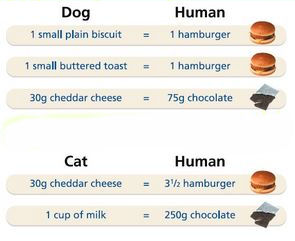Obesity is the most common nutritional disease of dogs and cats. In Australia, 41.5% of dogs and 32% of cats are overweight or obese.
Causes of obesity in pets

The causes of obesity are varied:
- Overfeeding as a result of unlimited access to food
- Dogs spend 60-70% of their day lying down with no physical activity
- Neutering a pet tends to reduce their energy needs by about 25%, making them more prone to weight gain.
Weight gain is the result of an increase in body fat. This is usually caused by eating too much, especially when combined with lack of exercise. But there can be other contributing factors too.
- Age: Older pets are less active, have less energy, and require fewer calories.
- Breed: Some breeds are more likely to gain weight. These include Labrador retrievers, Cocker and King Charles Spaniels and mixed breed cats.
- Neutering/ spaying: Clinical studies have shown that the basic metabolism of neutered pets is lower. Neutered pets actually require fewer calories.
- Medical Problems: Very occasionally weight gain is associated with a medical disorder that may require specific treatment.
Obesity is most common in older female animals.
Is your pet overweight?
All pets have an ideal weight for their size and breed but as a general rule, if you have difficulty in feeling the ribs, then your pet has a problem. You should be just able to feel the ribs with a small amount of pressure.
Dangers of carrying extra weight
It’s not easy for pet owners to admit that their pets have a weight problem. In fact many don’t see their pets as overweight. But facing the problem is vital to the health and longevity of the pet. Excessive body fat has detrimental effects on a pet’s health and longevity, and often reduces a pet’s enjoyment of life.
Diseases associated with or exacerbated by obesity include:
- Diabetes
- Arthritis and other joint disorders, spinal disc problems and ruptured ligaments
- Heart and respiratory disease
- High blood pressure
- Skin problems
- Heat intolerance
- Risk with surgery and anaesthesia
The reason for obesity
The food your pet eats plays an important role in their overall health and well-being. Balanced nutrition is an essential part of an active, healthy lifestyle. Although there may be some other slight aggravating causes, essentially the primary cause is eating too much food.
Many owners find this difficult to face this fact. However when you compare the amount of calories you are giving your dog or cat compared to the equivalent for a human, it soon adds up….
Management of overweight pets should include:
- Reducing your pet’s calorie intake by feeding a low calorie high fibre food specifically formulated for reducing weight, eg. Royal Canin has food for weight loss and weight management, as well as food specifically formulated for neutered pets.
- Keep your pet out of the room when food is being prepared or eaten.
- Do not feed overweight pets with other pets.
- Do not feed anything other than the amount of food prescribed by a veterinarian. This includes ALL edible material taken by mouth including sweets, treats, milk etc.
- Exercise your pet regularly.
- At least once a week weigh your pet and record its weight. Feel free to come into the surgery and use our scales. We can then record the weight on your pet’s file.
Exercise your dog’s playfulness
If you’re trying to reduce your dog’s weight or help your dog maintain a healthy weight, you can complement food with simple and fun exercises.
- Create a natural obstacle course with benches, trees, ditches or anything you encounter along the way that your dog can jump over, crawl under or balance on.
- Take a 30-minute walk around your neighborhood. This is a great way to exercise and bond with your dog.
- Play fetch with a ball or toy (never use a stick, as these can splinter and cause injury to your dog).
- Hide a toy or some kibble and let your dog find it.
Five steps to a healthier dog
How to make sure your dog attains an ideal weight – and maintains it for life.
1. Watch what your dog eats
Different dogs have different needs when it comes to nutrition. That’s why you should work with your veterinarian to make the right food choices for your dog. Together you can discover the right type and amount of food for your dog’s life-stage and health condition.
2. Track your Dog’s weight
Losing weight can help your dog achieve better health, but only if the weight is lost in a healthy, controlled manner. To make sure your dog is losing weight at a healthy pace, make sure to weigh your dog regularly and use a weight tracking chart to track your dog’s progress. Feel free to bring your dog into the surgery and use our scales.
3. Maintain a healthy activity level
Your dog’s weight management program isn’t complete without a healthy amount of physical activity. Whether it’s a game of fetch or a walk in the park, make sure your dog is getting the physical activity needed to get and stay healthy.
4. Visit your veterinarian often
Regular trips to the veterinarian ensure that your dog’s weight management program is going smoothly. Your veterinarian knows your dog’s ideal weight, how fast he should be losing weight and which foods are best for each stage of the weight loss plan.
5. Maintain an ideal weight for life
Your dog’s weight management plan should be life-long. Once your dog has attained an ideal weight, switch to a simple weight maintenance plan that consists of regular exercise and proper nutrition.
Exercise your cat’s curiosity

If you’re trying to reduce your cat’s weight or help them maintain a healthy weight, you can complement food with simple and fun exercises:
- Use commercial or homemade cat toys to encourage active play (such as a feather, cat fishing pole, foil balls and paper balls).
- Buy a tall scratching post to encourage your cat to climb.
- Shine a flashlight on the wall and let your cat chase it (do not use a red laser light, as it may damage your cat’s eyes).
- Let your cat play in a box or paper bag.
- Feed your cat in different places every day so they can hunt for the food. Make your cat work harder by using obstacles or feeding from tall furniture.
Five steps to a healthier cat
How to make sure your cat attains an ideal weight – and maintains it for life.
1. Watch what they eat
Different cats have different needs when it comes to nutrition. That’s why you should work with your veterinarian to make the right food choices for your cat. Together you can discover the right type and amount of food for your cat’s life-stage and health condition.
2. Track your cat’s weight
Losing weight can help your cat achieve better health, but only if the weight is lost in a healthy, controlled manner. To make sure your cat is losing weight at a healthy pace, weigh your cat regularly. Feel free to bring your cat into the surgery and use our scales.
3. Maintain a healthy activity level
Your cat’s weight management program isn’t complete without a healthy amount of physical activity. Whether it’s playing with a new toy or just a brown paper bag, make sure your cat is getting the physical activity needed to get and stay healthy.
4. Visit your veterinarian often
Regular trips to the veterinarian ensure that your cat’s weight management program is going smoothly. Your veterinarian knows your cat’s ideal weight, how fast they should be losing weight and which foods are best for each stage of the weight loss plan.
5. Maintain an ideal weight for life
Your cat’s weight management should be life-long. Once your cat has attained an ideal weight, switch to a simple weight maintenance plan that consists of regular exercise and proper nutrition.
Rewarding your pet
We all like to reward our pets. There are alternative ways to giving a reward without giving food.
- Praise and attention – give lots of cuddles and praise
- Fun and games – play games with your pet, they love interaction with their owners.
- Walks – you know how much they enjoy these!
- Patting – a relaxing and healthy way to reward your pet.
Needs some help and guidance?
The good news is that you do not have to do this alone. Nicklin Way Veterinary Surgery runs a free Weight Loss Clinic.





